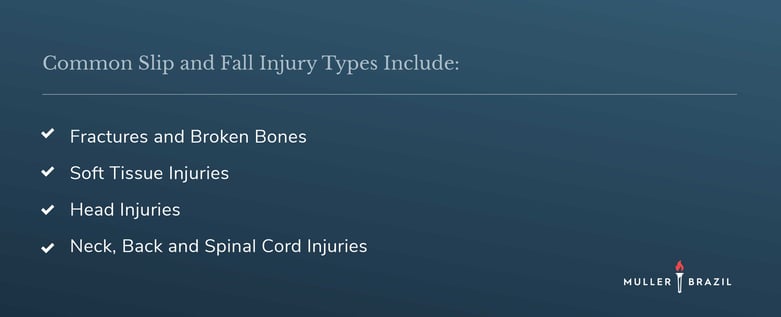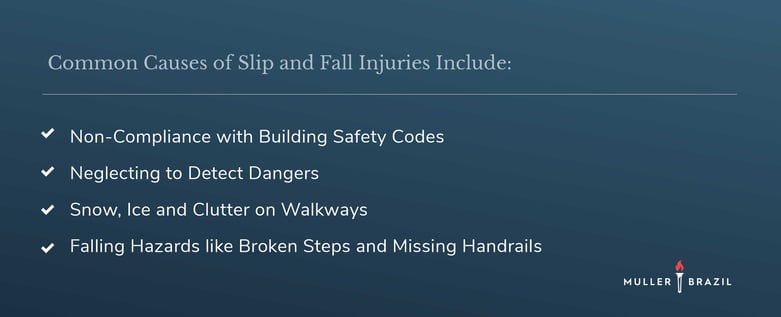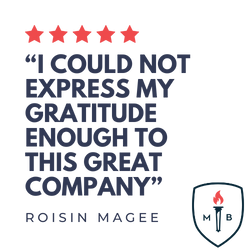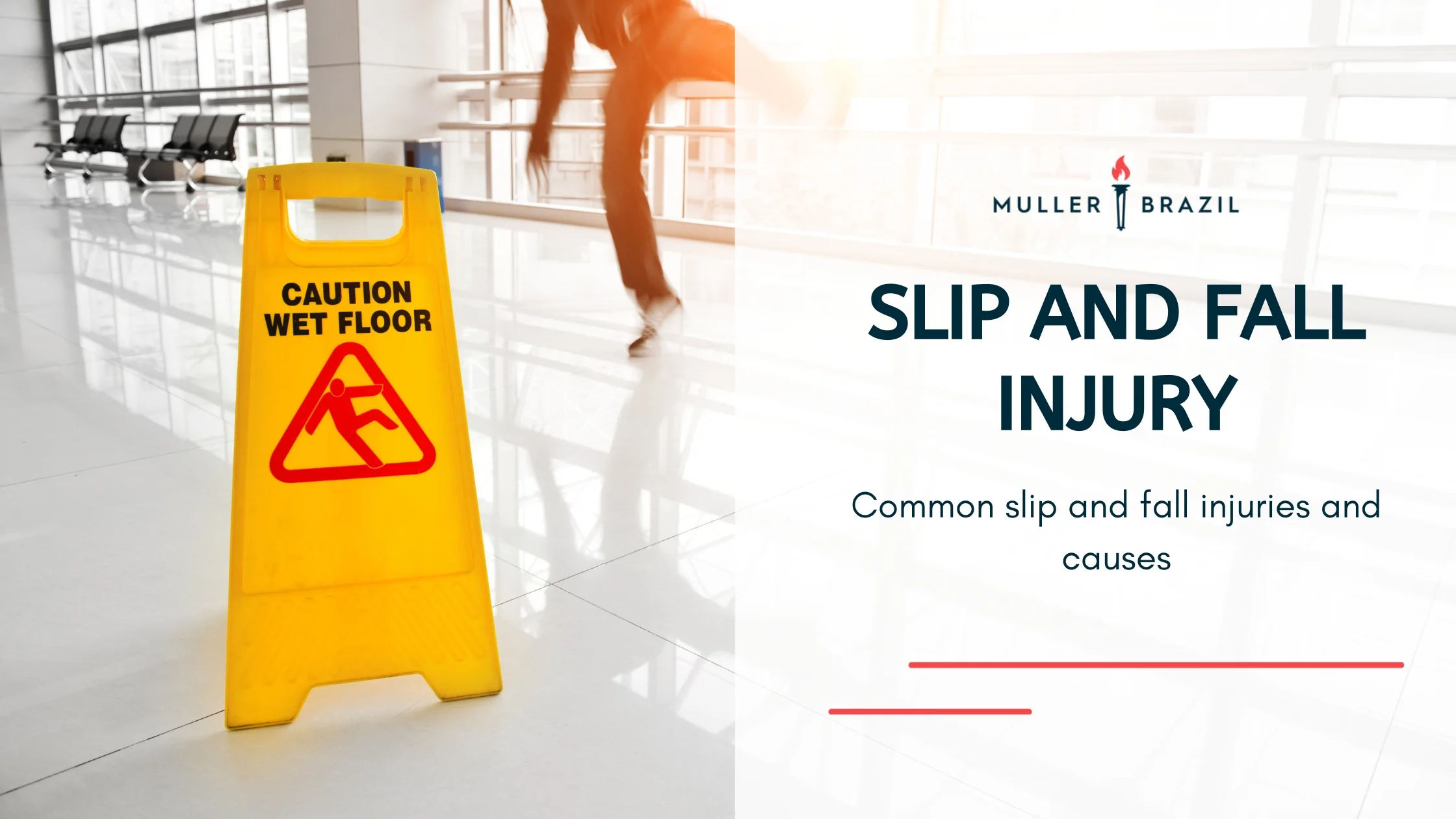6 min read
What Classifies as a Slip and Fall Injury
![]() Laura Levenberg, Esquire
Apr 6, 2022 12:56:37 PM
Laura Levenberg, Esquire
Apr 6, 2022 12:56:37 PM
Slip and fall accidents are some of the most common causes of injury in the United States, as over 800,000 patients are hospitalized each year following a fall. (Source) However, most people do not consider the dangers and expenses associated with these accidents until being directly affected.

Slip and Fall Injury Types
Common Injuries
Fractures and broken bones
Approximately five percent of slip and fall accidents involve fractures and broken bones. In addition to serious pain, a fracture can cause increased recovery time, emotional anguish and extensive medical costs. The older you are, the more likely you are to break a bone as a result of a slip and fall. Hips, wrists and ankle fractures are the most commonly broken bones, but the following are also susceptible:
- Elbow
- Foot
- Shoulder
- Hand and/or fingers
- Pelvis
- Forearm/wrist
- Knee
- Lower leg
Soft tissue injury
Soft tissue injuries are those affecting muscles, tendons and ligaments. The most common types of soft tissue injuries a person may experience after a slip and fall include sprains, strains and contusions. The severity of soft tissue injuries varies widely, with some minor injuries requiring only rest or a cold compress, and others warranting extensive therapy or surgical intervention.
A sprain, for example, is a stretch or tear to a ligament, which connects two or more bones in a joint. Symptoms include pain at the injury site, loss of use of the joint, bruising and swelling. A sprain typically only needs rest and other home remedies to heal properly. Contrarily, a severely torn ligament could require a demobilizing cast, surgery and rehabilitation. It is critical to seek medical attention to assess the severity of your injury.
Head injury
Perhaps the most serious of injuries stemming from a fall are those involving the head. Although we tend to associate head and brain injuries with contact sports, the most common way to suffer a brain injury is by falling. Injuries involving the head can be particularly devastating as the victim often does not realize the extent of the injury. Head injuries can be especially worrisome if the person is taking certain medications like blood thinners, and even minor head contusions can have lingering effects.
Common Head Injuries:
- Concussion
- Traumatic brain injury
- Skull fracture
- Hematoma or hemorrhage
- Edema
- Diffuse axonal injury
Neck, back and spinal cord injury
Neck or back injuries can be relatively minor or extremely severe. The most common types of neck and back injuries include muscle strains, neck sprains, whiplash, herniated discs, neck fractures, ruptured or slipped discs, spinal stenosis and cervical dislocations. Treatment varies depending on how badly the area has been damaged, the victim’s age and any preexisting medical conditions.
A person can injure their back or neck yet not sustain a spinal cord injury if only the bones around the spinal cord (the vertebrae) are damaged and the spinal cord is not affected. However, any damage to the cord itself can result in loss of function, such as mobility and/or feeling. Other effects of a spinal cord injury may include low blood pressure, inability to regulate blood pressure, reduced control of body temperature and chronic pain. Depending on the level of injury to the spinal cord, paralysis and loss of function could be minor or severe.
Common Back Injuries:
- Chronic back pain
- Herniated disc
- Fractured vertebrae
- Paralysis
- Brachial plexus
- Bruising
- Swelling

Common Causes of Slip and Falls
The duty of a property owner to alert a visitor of a hazard depends upon what sort of visitor is involved. Friends, family or guests of the property owner are normally classified as licensees and are owed a reasonable duty of care. The property owner must warn the licensee of any dangerous conditions on the property that the owner knows exists. A guest is classified as an invitee if he or she has either express or implied permission to be present on the property for some business or social purpose for the benefit of the property owner.
The property owner must maintain the property in a reasonably safe condition and either repair or warn the invitee of any dangerous conditions on the property that the owner knows or should know exists. A trespasser, however, is a person who enters onto a property without permission or consent of the property owner. The property owner owes the lowest duty of care to a trespasser and must only refrain from willful, wanton or reckless conduct that could harm the trespasser.
Non-compliance with building safety codes
In many slip and fall cases, problems with premises liability arise concerning the building’s design, construction and compliance with complex local, state and national building codes. Legal liability related to building compliance and safety regulations can be a complex issue. Owners, landlords or operators must exercise their own duty of care to mitigate risks to those on the property.
Of course, negligence can be established any time an owner, possessor, lessee or others in charge of a property fail a building inspection or violate a building order. However, regardless of whether a building owner has been cited for an infraction, the owner may still be liable if the injury was reasonably foreseeable.
Neglecting to detect dangers
Property owners or those who are responsible for the care and maintenance of a property are required to ensure a relatively safe environment for those who are present on the property. This responsibility is better known as “premises liability” and holds the owner or responsible party liable for accidents and injuries occurring on the property.
Generally, the responsible party bears the obligation to inspect the property. As explained above, the duty of the party depends largely on the classification of the visitor to the property. As a general rule, if a dangerous condition is found, the responsible party must either repair the condition or adequately warn the visitors of the potential danger. If the party is aware of a dangerous condition but fails to repair or warn of the danger, he or she may be held liable for any injuries suffered by a visitor due to the condition.
Snow, ice and clutter on walkways
In sidewalk fall accidents which occur due to snow or ice, liability does not normally attach unless there was an unreasonable accumulation of snow or ice. Pennsylvania courts have adopted a “hills and ridges” standard, where a fall victim must prove that the snow and/or ice which caused the accident accumulated to such an extent that hills and ridges of snow and/or ice formed. More specifically, the following three (3) elements must be shown:
The snow and/or ice had accumulated on the sidewalk in ridges or elevations which unreasonably obstructed travel and constituted a danger to pedestrians;
- The property owner had notice of the existence of the condition; and
- The accumulations of snow and/or ice caused the fall.
Falling hazards like broken steps and missing handrails
Businesses and property owners can take steps to prevent employee or customer injuries by making their buildings, properties or work areas safer. Warning signs and floor markings can alert people to slippery floors, missing handrails, broken steps, loose floorboards, and other possible dangers. Adding non-slip strips to steps, cleaning up food, drink or other spills, and keeping areas well lit are all easy ways to prevent falling.
If you are injured because someone else was negligent in removing or rectifying a falling hazard, you may be able to file a slip and fall lawsuit.
Failure to warn people if there is a known safety hazard
In most cases, a person injured in a slip and fall accident on someone else’s property must prove that the cause of the accident was a “dangerous condition” and that the property owner or other responsible party knew of the dangerous condition. If the condition presented an unreasonable risk to a person present on the property, and the person did not anticipate such a risk under the circumstances of their presence on the property.
In order to establish that a property owner or other responsible party knew of a dangerous condition, one of the following three items must be shown:
- The responsible party created the condition;
- The responsible party knew the condition existed and negligent failed to correct it; or
- The condition existed for such a length of time that the owner/possessor should have discovered the condition and corrected it prior to the slip and fall accident in question.
Fall Accidents Can Happen Anywhere
Slip and Fall Accidents can occur anywhere you are likely to be; including your own home. Dangerous conditions such as torn carpeting changes in flooring, poor lighting, cracked sidewalks, wet floors and narrow walkways could all be responsible for a slip and fall accident. It is imperative for the party responsible for a property to exercise reasonable care in management of the premises to ensure that visits are protected from an unreasonable risk of harm. If you or a family member have been hurt in a slip and fall accident, an experienced injury attorney can help you determine the value of your claim and decide the most appropriate action for recovery.
Places Where Slip and Falls Can Happen:
- Retail stores
- City sidewalks
- Businesses
- Restaurants
- Construction sites
- Parking lots
- Entertainment centers like stadiums, theaters, amusement parks
- Recreational parks and playgrounds
- Nursing homes
-
Private homes
Meet the Author
Laura Levenberg - Associate Attorney
Laura J. Levenberg is a vaccine injury lawyer at My Vaccine Lawyer. Prior to joining My Vaccine Lawyer, Ms. Levenberg worked as a trial attorney at a litigation firm specializing in personal injury matters, primarily arising from motor vehicle accidents and slip/trip and fall incidents. Laura has successfully represented clients in all stages of litigation, including depositions, negotiations, motion practice, oral arguments, arbitrations, and trial. Laura also serves as a certified arbitrator in Philadelphia County.
Learn more about Laura J. Levenberg ⇒






